Imagine this…You are one week out on a three week trip and you realize that funky odor is coming from your trash and there is no place to toss the bag and get it off the boat.
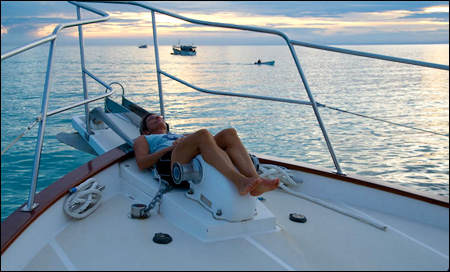
Okay, I might be a bit obsessive about my trash and I admit it, but I come by it honestly.
We have taken three trips, each three weeks in length up the Rio Macareo, one of the outflow rivers of the Orinoco. We have also spent a month in the Venezuelan out islands, Las Tortugas, Los Roques and Las Aves without a place to get rid of our trash.
If I know that we will be without a trash deposit facility for more than a few days I start sorting and managing the trash.
Sorting the trash
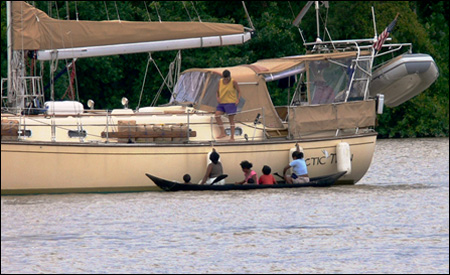 |
| In the Rio Macareo there was no trash deposit facility. |
Organic trash is all food waste and it gets deposited into a closed container. I use a 5-liter Rubbermaid container. The lid fits tightly and the walls of the container are straight, so it is an easy container to rinse.
Burnable trash, such as paper towels, toilet paper and any paper wrapping get segregated into a separate container. Since this will have to get burned I try not to put wet paper in the burnables and will even try to dry paper towels. This should be mostly dry and non-smelly. I keep the toilet paper in a separate bag and do not open that until the flames are hot.
Non-burnable trash will be all the plastic, glass bottles, cans and other food wrappers.
How we get rid of our trash
I keep my organic trash until I can toss it overboard in deep water or where it will not wash up on a beach or in view of someone. The Macareo River is a large volume river and a bit of food trash will not disturb the ecology of the river, but I did not want to be seen tossing trash in the river so I waited until dark to toss the trash. If we are at anchor every few days we take a dinghy trip outside the island water flow to toss the organic at sea.
The burnable trash can be burned when you have a beach or shore nearby.
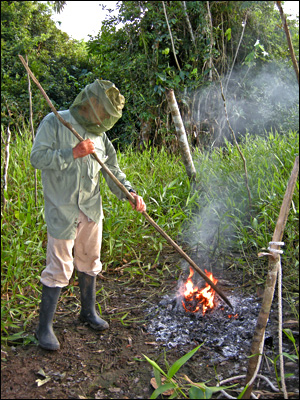 |
| Trash burning up the Macareo was a buggy affair. (Photo by Chuck Shipley) |
Getting the “burnable trash” to burn can be quite difficult.
Toilet paper does not burn well even before it is used – enough said on that.
We start a small fire with local wood and wait until it is a burning well before adding any of our trash.
My husband, Hunter, uses an accelerator fluid of approximately one part gas to five parts diesel. He mixes about a cup and we wet down the fuel before we light it. It is not safe to add the accelerator after there is fire.
If that makes you uncomfortable bring some dry newspaper and collect plenty of kindling and make a good fire before adding the trash.
Make sure you get all the stuff burned and put the fire out.
Trash burning up the Macareo was a buggy affair. On wet season trips we wore long pants, long sleeves and head nets.
The non-burnables are the most troublesome.
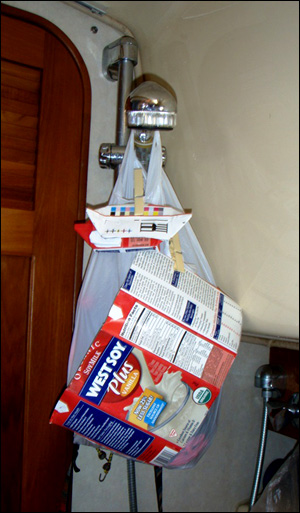 |
| Drying trash |
This is where I get a little obsessive. This is where you have to be meticulous.
You need to wash and dry everything before you toss it into the non-burnable bag. It will only take a few days for the tuna can to stink and then you have its company for the rest of the trip. That means plastic food containers, ziplocks that held food and even the tetra pack that held your milk.
You can use seawater for washing and then dry the trash (now, doesn’t that sound stupid?) and even after weeks at sea your trash should not be stinky.
If you are at sea or will be making passages in deep water you can sort out your bottles, cans and paper for deposit in Davey Jones’ locker, but make sure there is no plastic. The paper will float for a while, but soon will sink and disintegrate.
Here is the rule – no plastic in the sea.
About Devi Sharp
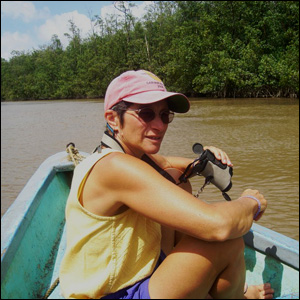 I come by my trash fetish honestly – In my misspent youth I was a river guide on the Rio Grande for week-long trips, and more recently Hunter and I have taken many long canoe and kayak trips in the Alaskan Wilderness.
I come by my trash fetish honestly – In my misspent youth I was a river guide on the Rio Grande for week-long trips, and more recently Hunter and I have taken many long canoe and kayak trips in the Alaskan Wilderness.
On all of these trips we had to manage our trash and in Alaska the trash had to be non-smelly and bear-proof. On the Grand Canyon kayak trips we had to pack out all trash (including the porta potty).
When I am not managing trash I hike on the islands, teach yoga, watch birds, write and chase green flashes.
We have been living aboard our Island Packet 45, Arctic Tern, since December 2005 and never looked back.
Read also on this website
More information (external links)
- Recent articles by Devi Sharp in All at Sea
- Devi’s blog: Artic Tern
How do you handle your trash when you are sailing in remote areas without disposal facilities?
Let us know.
Email kathy@forcruisers.com or leave a comment below.

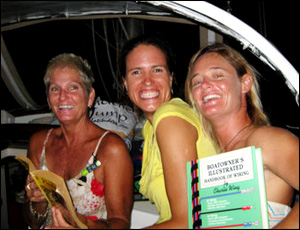
Some thoughts on the great litter mountain debate…
It is great to hear how Devi cares about rubbish and her thoughtful solutions on dealing with the detritus that humans increasingly accrue. My husband and I spend many a ‘well-chewed-chocolate-biscuit-and-tea’ session discussing the ‘fineries’ of rubbish and how best to deal with it. Even when there is a rubbish bin close by, how do we know that it is not to be destined for a pristine forest, dumped into the sea or simply slung over a nearby cliff?
Over the past two years, we have been surveying breeding seabirds throughout the Lesser Antilles and in the course of our work have become familiar with the less savoury side of human waste. Grenada’s dump constantly smoulders noxious fumes into the sky; St Eustatius’s dump spews onto a beautiful beach with one of the key nesting sites for Red-billed Tropicbirds and Leatherback Turtles; Saba’s fills a ravine where hundreds of cats gather and are rapidly removing the last traces of the endearing native Audubon’s Shearwater; whilst St Maarten appears happy to fill in one of the last ‘wild’ areas on the island- the salt lagoon at Philipsburg, home to Black-necked Stilts, Snowy Egrets, White-cheeked Pintails and many other beauties.
We have similar strategies to Devi: we separate all waste; composting organic matter in a container over a couple of days/weeks where it quickly breaks down in the tropical climate, before it is either destined for the deep sea or preferably dug into a hole on the mainland. Tissue and unlaminated/unplasticated paper is torn into small pieces and discarded in the deep sea (not a happy solution, but we prefer this method to burning it and releasing CO2) and some bars/shops will take glass bottles (we have had success on Carriacou, Grenada and St. Lucia). The French Islands have recycling and Antigua limited recycling, so we save plastic container, glass and paper for those islands too. We don’t know if they actually do recycle, but at least we are supporting a greener solution.
Finally, as so many readers will already be doing, we buy food with limited/zero packaging, so we don’t have to deal with the problem in the first place. I never accept plastic bags (all the shop keepers in the Lesser Antilles think I am quite batty as I constantly refuse what they must feel to be an added value to the good) and we buy local vegetables and meat from the markets wherever possible so we can just bring our own bags and not deal with packaging. The Caribbean is certainly a long way behind many areas of the world when it comes to rubbish, but every now and then I am shocked as an islander whips out her cloth bag proudly! I think we must all learn from the Germans here, they are super efficient; you actually get paid when you return packaging for reuse!
Very best wishes,
Katharine
Katharine Lowrie
http://www.listalight.co.uk
What a great article Devi!